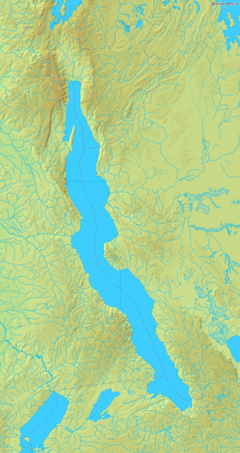Lake Tanganyika
So after a very emotional day we drove for a bit of sightseeing. We ended up driving on a half-built 100 mile new Tarmac road, courtesy of China and their One-Belt One-Road Initiative, to the shores of Lake Tanganyika. This was mostly a sightseeing trip so what will follow is some great shots of us on the shores of this beautiful great lake of Africa enjoying a lunch and hanging out together. For those more serious about the details see the bottom of the photos for the history of this place.
 |
| Our Guide, Ernest Lugalla, enjoying the view to the Lake |
 |
| Susi and I tried hard all day to get our anniversary shot. |
 |
| Dad after a long day of Stove building on the shores of Lake Tanganyika |
 |
| Emma, looking across the lake to the Congo. |
 |
| Sunset on a great day. |
| Lake Tanganyika | |
|---|---|

Lake Tanganyika from space, June 1985
| |

Lake Tanganyika map
| |
| Coordinates | 6°30′S 29°50′ECoordinates: 6°30′S 29°50′E |
| Lake type | Rift Valley Lake |
| Primary inflows | Ruzizi River Malagarasi River Kalambo River |
| Primary outflows | Lukuga River |
| Catchment area | 231,000 km2(89,000 sq mi) |
| Basin countries | Burundi DR Congo Tanzania Zambia |
| Max. length | 673 km (418 mi) |
| Max. width | 72 km (45 mi) |
| Surface area | 32,900 km2 (12,700 sq mi) |
| Average depth | 570 m (1,870 ft) |
| Max. depth | 1,470 m (4,820 ft) |
| Water volume | 18,900 km3 (4,500 cu mi) |
| Residence time | 5500 years[1] |
| Shore length1 | 1,828 km (1,136 mi) |
| Surface elevation | 773 m (2,536 ft)[2] |
| Settlements | Kigoma, Tanzania Kalemie, DRC Bujumbura, Burundi |
| References | [2] |
| Official name | Tanganyika |
| Designated | 2 February 2007 |
| Reference no. | 1671[3] |
| 1 Shore length is not a well-defined measure. | |
Lake Tanganyika is an African Great Lake. It is the second oldest freshwater lake in the world, the second largest by volume, and the second deepest, in all cases after Lake Baikal in Siberia.[4][5] It is the world's longest freshwater lake.[4] The lake is divided among four countries – Tanzania, Democratic Republic of the Congo (DRC), Burundi, and Zambia, with Tanzania (46%) and DRC (40%) possessing the majority of the lake. The water flows into the Congo River system and ultimately into the Atlantic Ocean.


Comments
Post a Comment